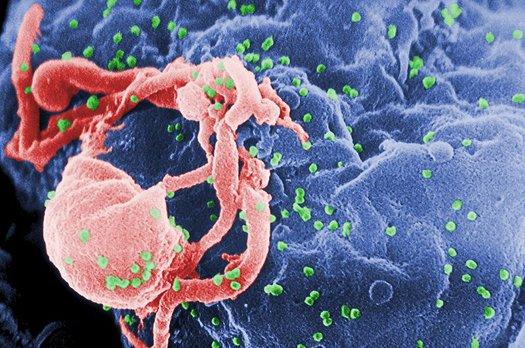Scientists Capture HIV Spreading Through The Body In Real Time
Which could lead to better ways to stop it

Scientists know a lot about HIV—how it’s transmitted, the virus’ life cycle, and where it likes to hang out in the body. But they haven’t had a good understanding of how it moves between cells in the body, and they have never been able to actually watch it spread. Now a team of researchers from Yale University led a study that recorded the virus infecting the lymph nodes in a mouse to better understand how it infects the body, with the intention of being able to stop that spread in the future. Their work was published today in Science.
As its name implies, HIV infects the body by hijacking the immune system and killing off its T cells, which are essential to staving off infection. Much of the immune system’s function is connected to the lymphatic system, so it’s no coincidence that HIV heavily concentrates in the lymph tissues. In many cases, HIV starts in the lymph nodes, which enables it to disseminate through the rest of the organism.
In this study, the researchers tagged HIV with fluorescent markers, then injected the virus into mice. They used a special imaging technique called two photon laser scanning microscopy that allows them to see about one millimeter deep into a living organism. Then they watched the virus closely to see how it spread. They found that the virus uses a protein to bind to macrophages, a certain type of white blood cell found in the lymph nodes and thought to be the immune system’s first step in launching a defensive response. You can see this process, here, in which the virus is stained green.

Then, the virus adjoins to another kind of white blood cell unique to lymph tissue called B cells. These cells are responsible for making antibodies and act as carriers between the inner and outer parts of the lymph nodes. If the virus infects B cells, then the body won’t produce antibodies to stave it off. The researchers found that infected B cells moved much more slowly within the lymph nodes. Within a few days of attaching themselves to B cells, HIV cells can infect much of the interior of the lymph nodes, destroying T cells and enabling the virus to spread throughout the body. Here, the B cells are in red, moving between the inner and outer parts of the lymph node:

The researchers were surprised to find how efficiently HIV moves between cells in the body. But now that they have a better understanding of how the virus moves throughout the lymph nodes before moving to the rest of the organism, they might be able to stop it. With much more research, the study authors hope to figure out how to do this, though they hypothesize that the key might be to block the virus from sticking to the macrophages at the start.